Overclocking -
Our A55M-DS2 was not a great overclocking board. Despite spending extra time with it we were not able to get it to overclock very well. Even smaller overclocks were plagued with issues whenever we rebooted the system. In the end we started at stock speed and walked up 1MHz at a time until we hit our max stable clock of 2.808GHz. Not much of a jump at all really, but then again this is not what you would call an enthusiast or overclocking motherboard.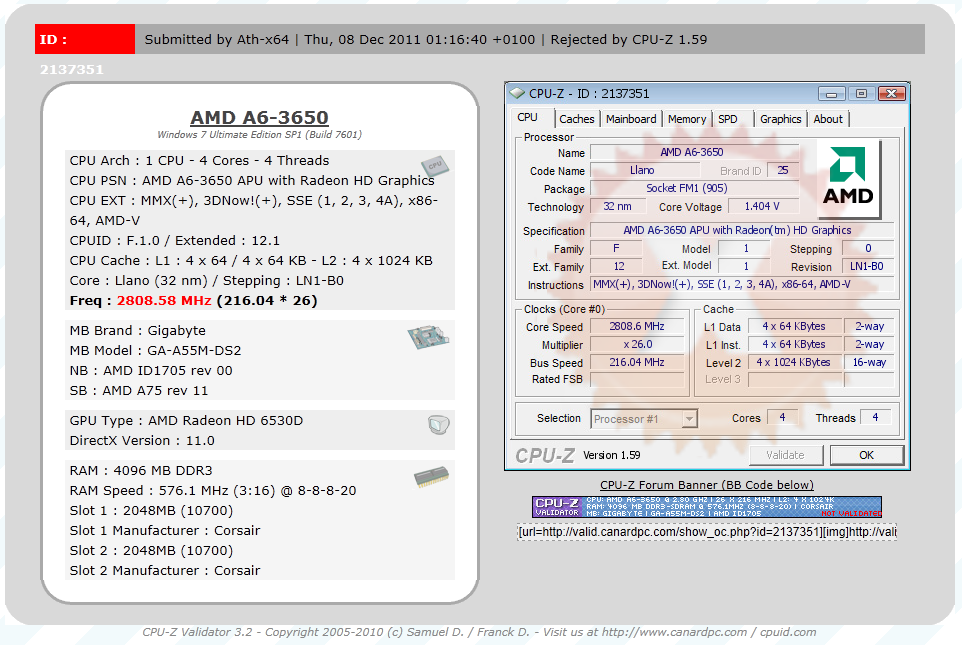
Of course overclocking is a picky subject. I can buy to identical CPUs from the store and they will not always perform the same way under stress. This is the same with motherboards, RAM and GPUs. So again it is important to keep in mind that our results represent a specific hardware configuration. Yours may be similar but will rarely be identical.
Overclocking Tools -
Gigabyte’s tools of choice is EasyTune6. This is a suite of tools that are combined in a single UI. I have to say that in my opinion the UI is a little boring and there are pages that get in the way of what it is intended to do. However, this does not take away from the functionality or the performance; this is just a personal thing. The first two pages get you the same information as you find get from CPUz. It is not until the third page (well really the first page when you open the application) that you get into the real workings of EasyTune6.
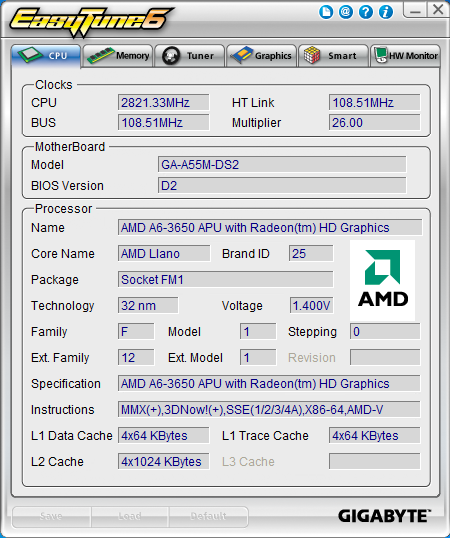 |
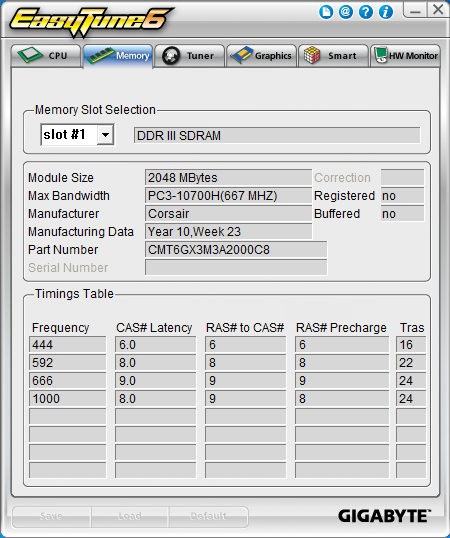 |
The third page in is the Tuner Page. You start off on the Quick Boost page. Here you have three options for a one stop overclock. The first two are probably places that you won’t want to go if you bought this board and the third; well that is just a pit stop on the way to higher speeds.
 |
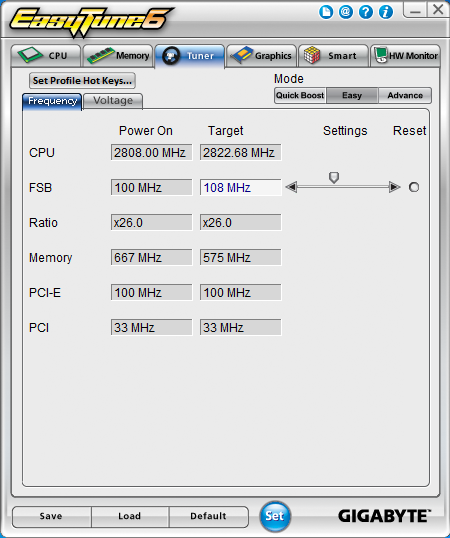 |
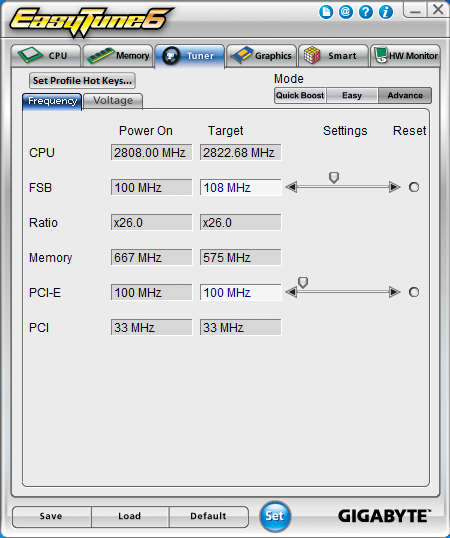 |
If you are looking to do some real damage; you will want to skip over the “easy” button and head right on into the advanced settings pages. Usually you can really tweak things here, but for some reason on the A55M-DS2 things are more limited. You have access to the FSB and PCIe, but not to memory or other frequencies. Ratios are also locked here for some reason.
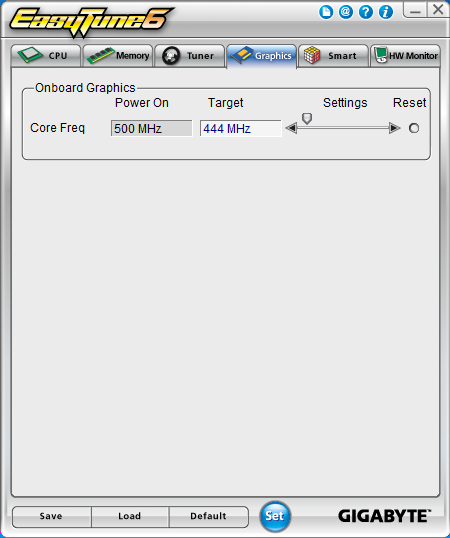 |
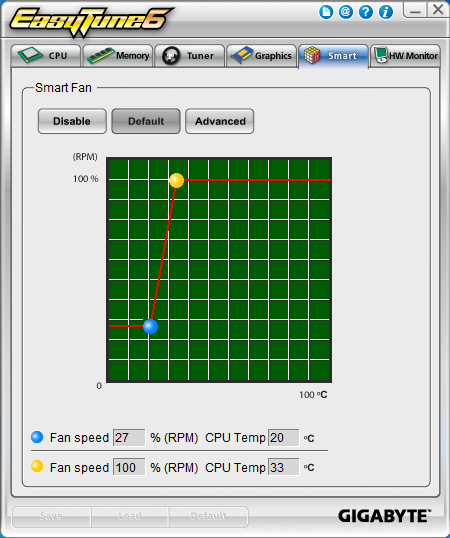 |
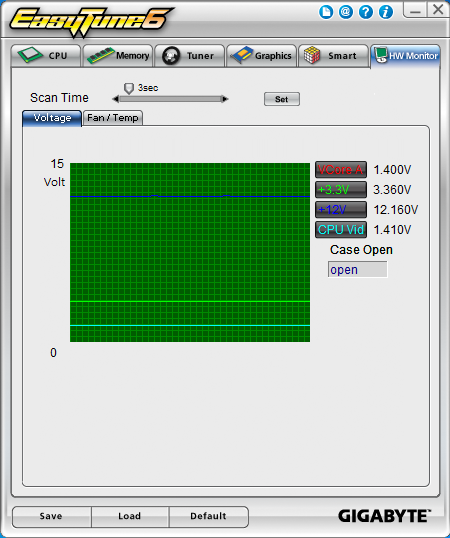 |
The next three tabs let you OC the GPU (well most of them), setup and work with the Smart Fan settings, and monitor the temperatures and voltages. I have honestly never used the GPU overclocking function but I have tinkered with the smart fans and the H/W monitor.
The Test System and Comments -
Our test system is built on an open bench. This has two effects on testing. First it allows us to see everything and also to setup and disassemble the test rigs quickly. Second it means that we cannot gauge the potential air flow found in a normal case. The air is pretty stagnant; some may say this is a great neutral testing method and it can be. However, it does mean that the temperature reading taken off of the components are not accurate to what an average consumer would see. This means that your thermal performance will vary from what we see here.
The A55M-DS2 is an interesting board. The setup and configuration was very simple. It was almost a two-step process. You install Windows 7 then you install the drivers and utilities. From there you are off and running. However, it was not all fun and games. We ran into a few issues when we were testing. When we tried to drop in our Asus HD5870 V2 we found that all of the SATA ports were in the way.
We tried multiple things to get around this but even 90-degree angled cables would not let it fit. In the end we were not able to test with the 5870 in the system. Now this does not mean that you cannot use any add-in card, it just means that you will have to make sure that you chose a slim one or one that is short enough that it does not get in the way of the SATA ports.
Performance testing overview -
Our testing is a little different than most. We combine both synthetic and real-world applications to simulate the types of performance common to the individual products. For motherboards this means that we run roughly six synthetic tests and two real-world. We will be expanding the real-world testing in the near future. But there is more to performance than just the raw numbers. As there are multiple components and sub-components on a motherboard there each item can have a distinct impact on the way the product will perform once you get it in your system. It is important to note not only the actual results but what they mean to you as a potential consumer. We will try to give this information to you. But we do not just cover the performance aspects that are measurable. We also talk about the components that might not have a direct benchmark. These are items like Audio Quality, ease of use and installation.
Section 1 Subsystems
Memory -
Memory performance is very important on a motherboard, especially when you have a CPU with multiple cores and threads. If you have slow memory your cores and threads can become starved for data to execute. To test memory performance we run both Sisoft’s SANDRA and AIDA64. These two combine to not only give us accurate numbers but to validate each other. For testing at stock speeds the memory is hard set to 1600MHz while overclocking testing is done at the highest stable speed for the voltage of 1.65v this is due to the different memory dividers for each CPU. As such, the memory speeds will vary greatly. This means that the overclocked numbers are a little misleading and while they can show a trend are really only included to show if a board has a problem with memory performance at high clock speeds.
The A55M-DS2 is just a hair behind the A75 chipset here. This is not that big of a surprise though as the memory controller is on the CPU (APU) and not the board. The difference here can be put down to differences in the boards tracing layout and/or BIOS. Additionally the difference is so minor that realistically you would never see if you had these systems sitting side by side. Unfortunately our overclocked scores dropped because the board and CPU combination did not like memory running over 1333MHz. It simply refused to boot into Windows. 
| AIDA64 Memory Performance Stock | AIDA64 Memory Performance Overclocked |
 |
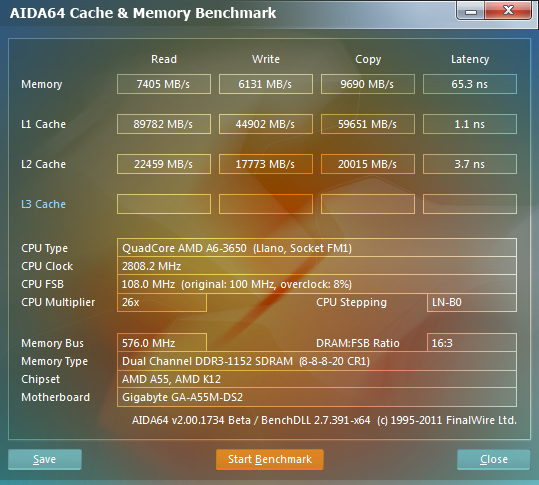 |
Drive performance -
Drive performance is also one of the major subsystems that goes to make up the performance of a motherboard. For our testing we use Sandra and AIDA64 again. We only test with single drives for each type of controller present on the motherboard (unless it is a professional product where we will use RIAD 5 and/or 10). We have also begun using a Seagate PS-110 USB 3 external HDD for our USB 3.0 performance. As a side note, we include the overclocked numbers here to make sure (again) that you are not going to see a major drop in performance due to minor instabilities at high clock speeds.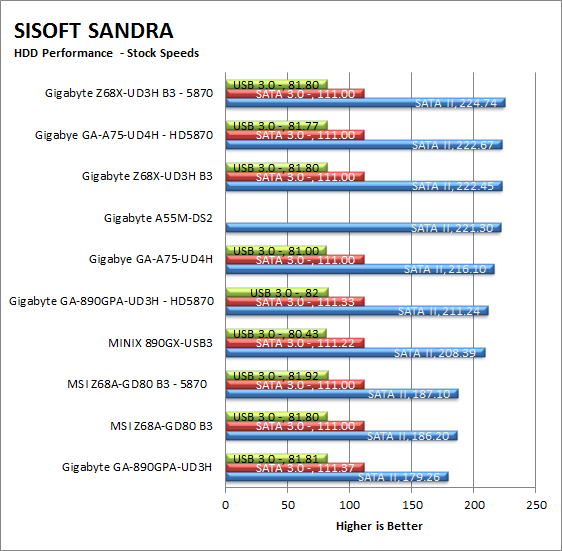
The HDD speeds on the A55M-DS2 are pretty good. I was more than a little surprised that they were as good as they ended up being. This is actually a good thing for the market that the A55M is aimed at. It means that it should be very good at running multi-media content stored directly on the HDD. 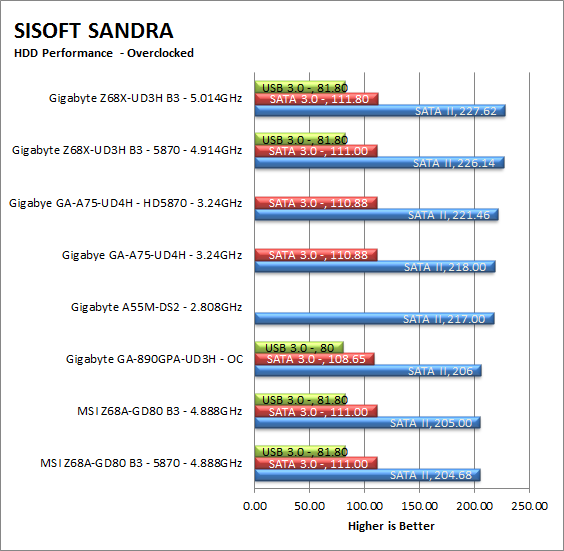
| AIDA64 Stock HDD Performance | AIDA64 Overclocked HDD Performance |
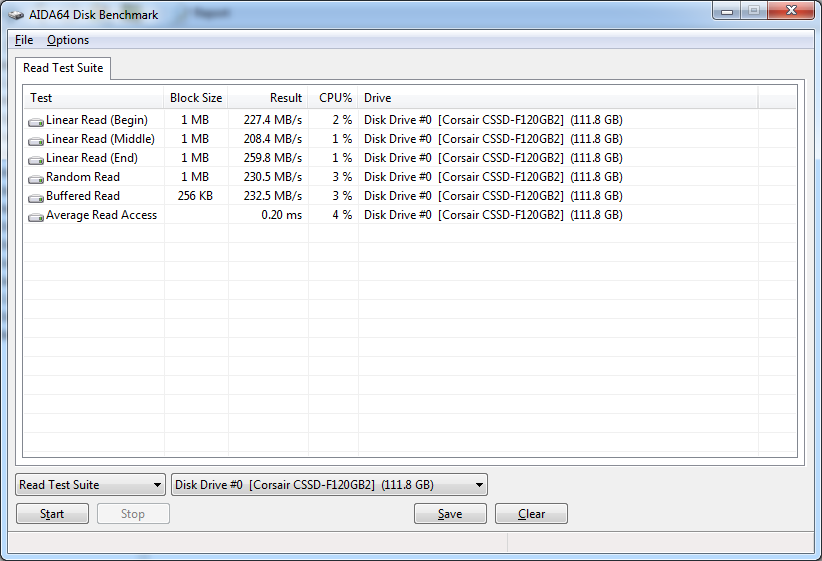 |
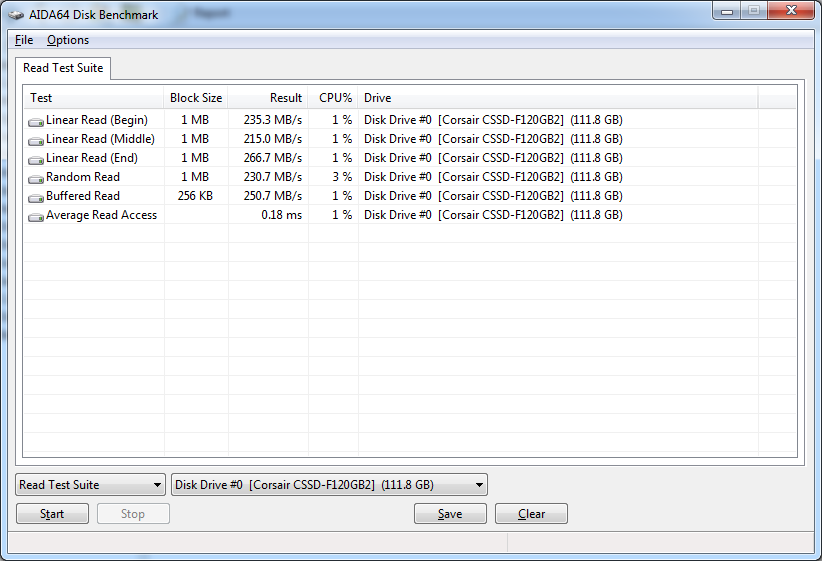 |
Power -
Power efficiency is another of those misnomers that we get caught up in. We hear about idle states and power gates. But what does that mean to you and I? On the surface having power management that reduces idle power sounds great and can be a benefit to someone that leaves their system on for long periods of time (and inactive) but how a system handles power under load and the delta between the two states is often more important than the idle power usage numbers. We use only P3 Kill A Watt instruments for measuring power. 
Not surprisingly the A55M-DS2 is a power efficient board. I was surprised to see that the Gigabyte Z68 with the 2600K used less power under load, but I have a feeling that is due to the APU kicking in during our combined testing run. 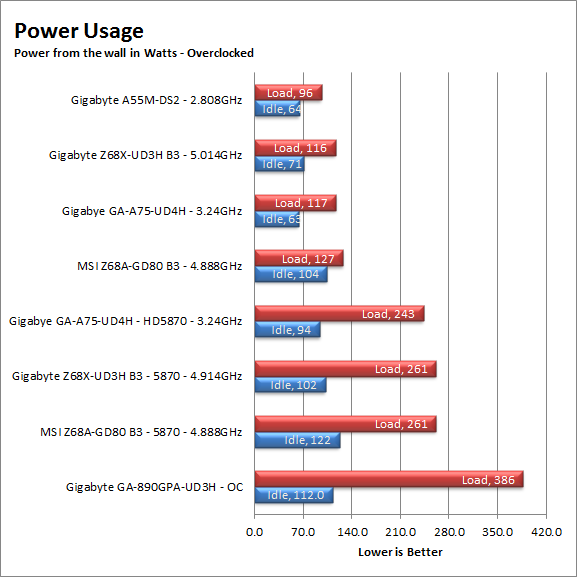
Cooling (Board Level) -
Board level cooling is an important factor in product performance and longevity. Components like the chipset, VRM modules and even capacitors need to be kept relatively cool to prevent failure. As these parts are made of silicon, they have a thermal breakdown threshold; or melting point. At that temperature the actual transistors built into chip will begin to deform and break down. Granted, the threshold is often very high, but you still need to make sure that components stay away from this level of heat for longer product life. 
The cooling on the A55M-DS2 is not the best out there. In addition to seeing higher temps than we would have expected from a board like this, we also found that the voltage regulation module area was rather warm. We found temps around 50c even at idle. This does not bode well for component life, at least not for the voltage regulation area. This is even more true when you consider that this board will probably be put in a small case with little to no air flow.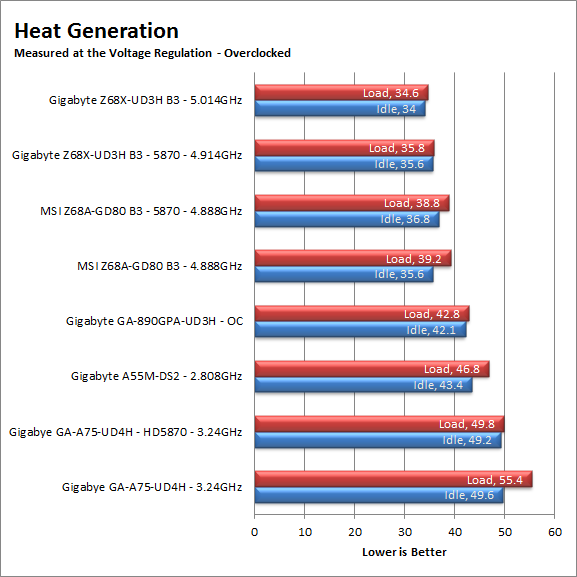
Audio -
Audio is highly subjective. What we find pleasing may sound “off” to you. That is always going to the problem with testing audio; results will vary too widely depending on the tastes of the listener. However, there are ways of measuring the audio output with an objective ear. There is also the issue of audio causing performance issues in gaming and video playback. The reason this is a potential source of concern is that all onboard audio CODECs (Compression/Decompression) are CPU controlled. This means that while the audio chip controls the audio levels and effects of the audio the actual work is done on the CPU. Usually this will not be a problem with today’s powerful CPUs. Even the lower and consumer level products can handle high-end audio these days. But again there is the chance that a bad design or software will hinder your system and performance. On the other side the limits of board space, cost, etc will also prevent the level of audio quality you can get from an add-in board. We test all audio parts with three media types, Movie (DVD), MP3 Music, and Gaming. These are pushed to our Tec On model 55 Tube Amp to see if we can detect any signal issues in the reproduction.
The audio on the A55M-DS2 was not world-class. It will get the job done, but do not expect to be stunned with its performance.
Networking -
This one is something that is a requirement anymore. If you have a computer, the chances are good (like 99%) that you are also connected to high-speed internet. With this you need a good and solid LAN chip to make sure that your data flows properly out and back. The networking was also on par with what you should get from a Gbe (Gigabit Ethernet) chip. It will do what you need it to do including streaming media from a local share (like a NAS or home server) or from Netflix of Hulu.
Section II - Performance Tests, Synthetic
In this section of testing we cover the synthetics. These are tests that run a scripted sequence of internal APIs or that use another installed application to perform a series of scripted events. They are great in that they can provide reproducible results across various platforms. On the down side, synthetic tests can be fooled with driver tweaks and optimizations. In some cases it is necessary to rename the .exe file to something generic to discover if this is the case. In any event when this is needed (when a test shows a drastic difference in performance over the renamed exe) we will note this and show both results for comparison.
PCMark Vantage -
PCMark Vantage is a suite of tests designed to test the power of your computer. It runs task that range from productivity to gaming (DX9 only). It is a great test to identify potential problem areas with general performance on a system. It can also show how well a single component can increase or decrease system-wide performance. We run both the x86 and x64 PCMark Suites for testing.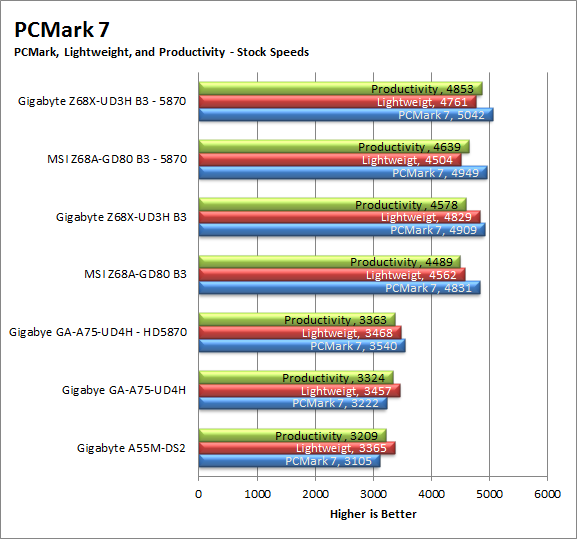
As you might have expected the PCMark 7 scores are at the bottom of the list. It is important to remember that this product also has the lowest combined cost of all of the other test systems. If you look at it in terms of performance vs. price it is not such a bad showing after all. 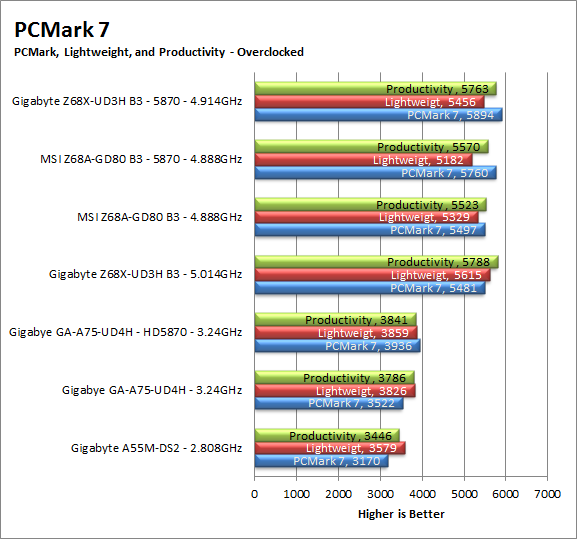
3DMark 11 -
3DMark 11 is the other Futuremark test that we run on our motherboards. This test simulates the typical tasks that a GPU (and system) would have to perform to provide you with a good gaming experience. It is based on the DX9, DX10 and DX11 engines but can only be installed on Windows Vista or later. The suite of tests covers DX9, DX10, and of course DX11 rendering; it also covers AI computations and physics. That’s right I said Physics the latest version of 3DMark uses a Havok physics engine. This removes the advantage that nVidia had with 3DMark Vantage. 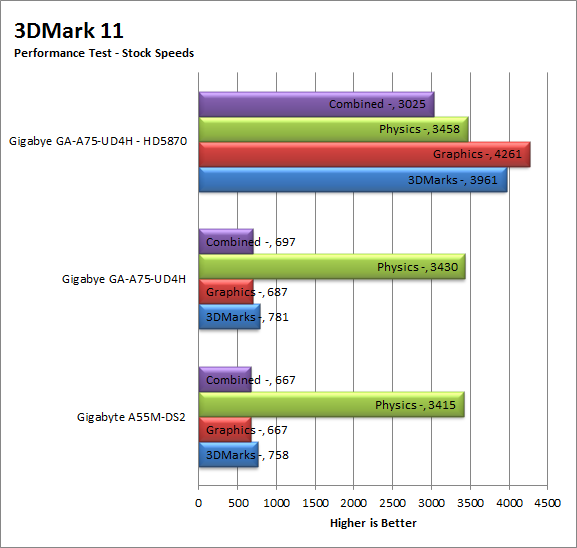
Again the 3DMark11 scores are low like the PCMark7 Scores. However, as we mentioned before this system also has the lowest cost. It is also not meant as a hardcore gaming platform. The simple fact that it is able to run 3DMark11 and bring in a score in the mid-600s is very good. Intel’s Sandy Bridge CPUs cannot even run DX11 yet. We will have to wait for Ivy Bridge for that feature. 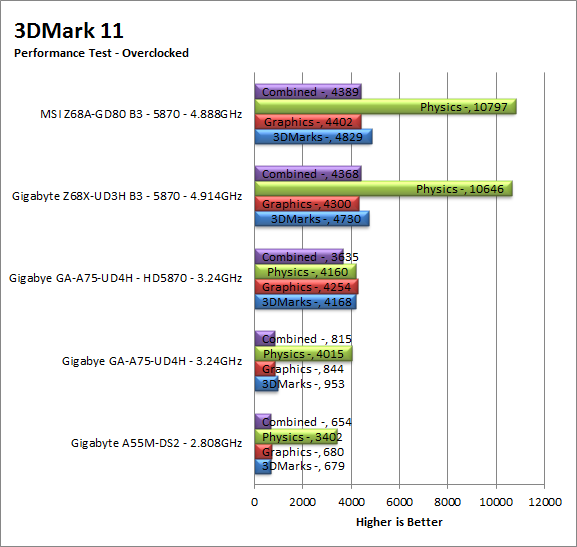
HyperPi 0.99b -
HyperPi is a front end application that allows you to easily run multiple instances of the SuperPi application. SuperPi, for those that are not familiar with it, is an application that measures the time it takes to calculate the number Pi out to as many as 32 million places. This calculation is then checked and run multiple times (up to 24 for a 32M run). This test stresses the CPU, Memory and HDD as data is handed off between the three. If there is a weak link, HyperPi will show it. For our testing we run the 32M test on as many cores (and threads) as the CPU has available. The slowest CPU time is then recorded. 
The HyperPi Scores were never going to be great. We knew this going into the testing because the scores on the A75 were also not outstanding. They are good for what you have (a small inexpensive CPU and motherboard), but you are not about to win any speed contests. Still we do know that the A55M-DS2 can crunch numbers for you, it is just going to take some time doing it.
Cinebench R11.5 -
Cinebench R11.5 is the 11th release of Maxon’s rendering test. This test is based off of the Cinema 4D engine, which is one of the industry standard tools for digital animation. It is a powerful product with many different modules that can be “plugged” into it to increase its effectiveness. With Cinebench you get to see how your computer would do using this application. There are two tests; one tests the CPU’s ability to render an image across multiple cores or threads. The other tests your systems ability to handle OpenGL based rendering. 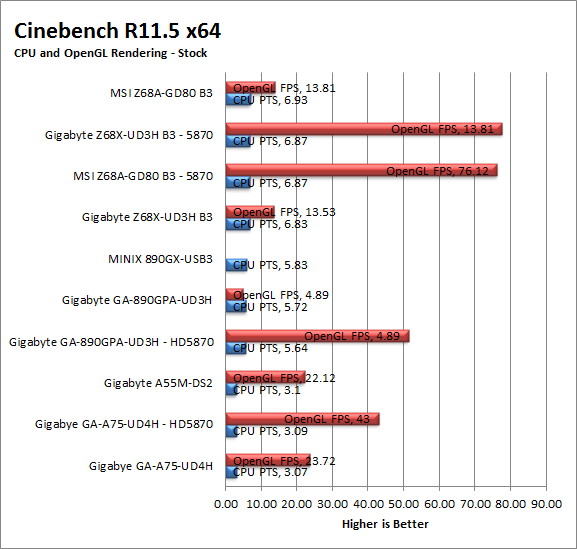
This is interesting; the A55M-DS2 is a little faster than the A75-UD4H when it comes to Cinebench R11.5. The speed difference is even more surprising considering that the A75 is faster in memory performance.
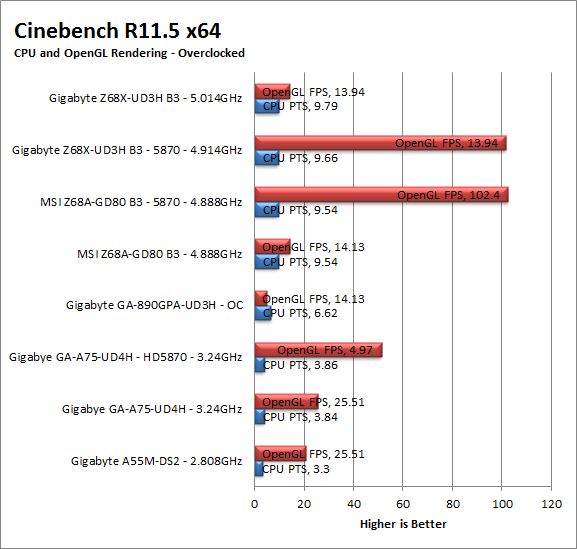
Section III - Performance Tests, Real-World
Here we have two tests that are designed to put the performance of the motherboard and its subsystems to the test. Both require good CPU, Memory, HDD and even to a lesser extent audio and network performance. The two tests we chose were Lightwave 3D 9.6 and AutoGK 2.55. We will be adding at least one more real-world test to this battery in the near future, but for now these two cover quite a bit.
Lightwave 3D 9.6 x64 -
Lightwave is another industry standard application for 3D animation and rendering. It has a large tool base and the rendering engine is highly threaded (when using the right render model). This application is also capable of expanding to 4k resolutions as well as ray tracing for rending the light sources. For our testing we use frame 470 of the Pinball scene found in the LW 9 Content folder. This uses the newer perspective camera that is better suited to a multi-CPU/Core environment. This camera style also uses ray tracing and a much improved anti-aliasing method. Settings are shown below in the attached screen shot. Of course these are single frame renders and they are not a complete picture; for that you have to take into account the number of frames an average project would have. In a typical 30 second commercial you will have around 840 to 960 frames (at 28 – 32 FPS) this means that you have to multiply the time of a single frame by that number just to get a vague idea of how long that 30 seconds would take. This is because each frame will have a different render time based on complexity.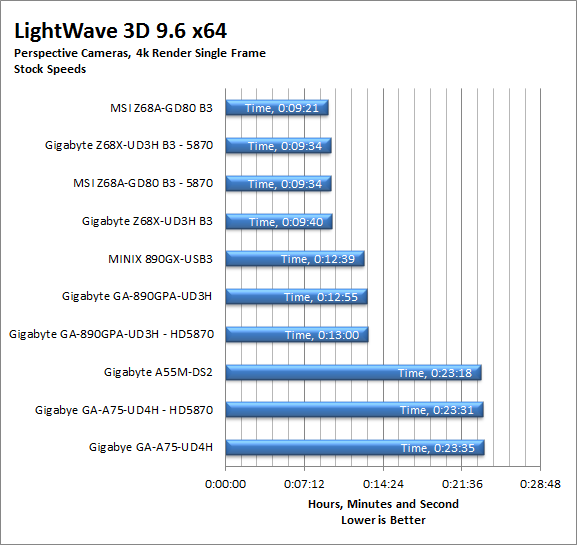
As with the Cinebench scores, the Lightwave scores here only serve to show that you would not want to pick up the A6-3650 and A55 combination for rendering. The issue is the slow memory performance and caching. This is not a huge concern for the market that this APU/motherboard combination is for though. You might find the odd person that will want to run a higher end video effect application, but for the most part it is highly doubtful that the A3650 or any of the chipsets that support it will be spending time rendering 3D video at 4K resolutions. 
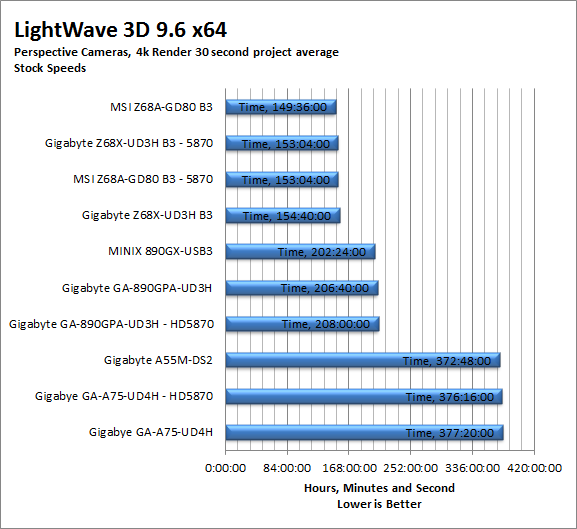
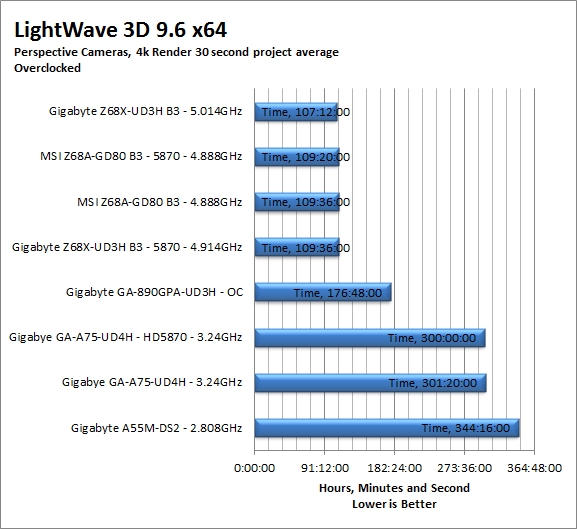
AutoGK 2.55 Transcoding -
AutoGK is a transcoding software that is really multiple parts combined to make an easy to use whole. It combines, items like FDD Show, Xvid encoder, Virtual Dub and others for use in converting one media format to another (usually Xvid AVI). It will not transcode copy protected DVDs or Bluray discs yet (you still need a decrypter for that). But it does an excellent job on everything else. For our testing we use a 2 hour movie that has been placed onto a standard definition DVD for playback; we then transcode this DVD to a 100% quality AVI with the original audio intact. This puts a strain on the CPU, Memory, HDD and the attached DVD ROM drive.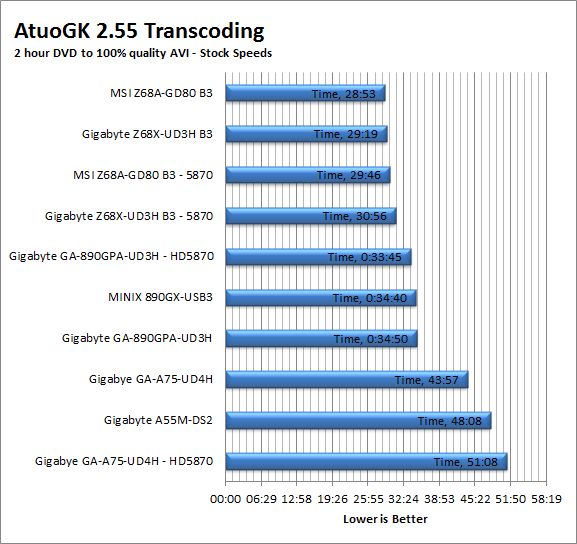
While the times we see for AutoGK are not especially fast, they are not terrible either. If you are looking into getting an AMD APU and an A55 board, I would honestly look into a transcoder that has a little less overhead than AutoGK. Of course you cannot beat the price on AutoGK (free is a great price).
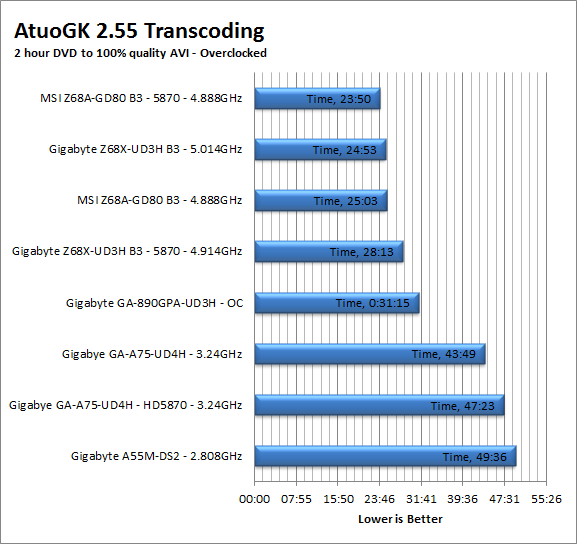
Section IV Performance – Gaming
Gaming as a test of motherboard performance is sort of a joke these days. The big player in the gaming arena is the GPU. Everyone but a few hardcore PR teams know this. However, it is important to run at least a few (one from each current DX version) to see if there are any issues with the combination of components on a motherboard. These are items like Audio lag, memory lag and of course problems with the PCIe lanes and signal traces. If there are issues in design, drivers or BIOS then you can have odd gaming performance. So without much more preamble let’s dive into the three games we currently use; Call of Duty Modern Warfare 2 for DX9 FarCry 2 for DX10 and Battlefield Bad Company 2 for DX11.
Call of Duty Modern Warfare 2 DX9 -
This is an excellent but short game that put you right into the action from the beginning and does not let up the pressure until the very end. The graphics are a little better; most notably the night and thermal imaging have been improved. The AI is still the typical COD “bar fight” style AI, with maybe a tad more finesse. All in all it is not a bad game to play and a decent one to use for testing. Our testing run starts at the bridge and ends after you clear the school in the first level of the game. Settings are shown below as are the performance numbers.
 |
 |
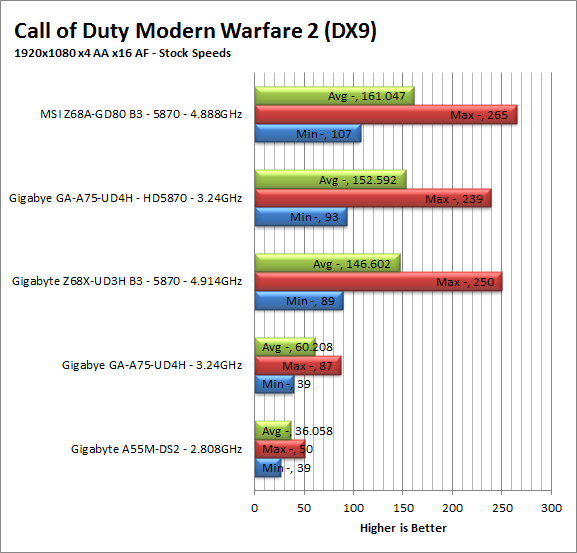
Modern Warfare 2 on the A55M-DS2 is more than playable with a minimum frame rate of 39FPS. This is over our minimum for full fluid motion and we even had some of the eye candy enabled. The game did feel a little sluggish when a lot of enemies were on the screen. This appears to be an issue with the CPU’s ability to process all the AI commands rather than the APU’s ability to render the scene. 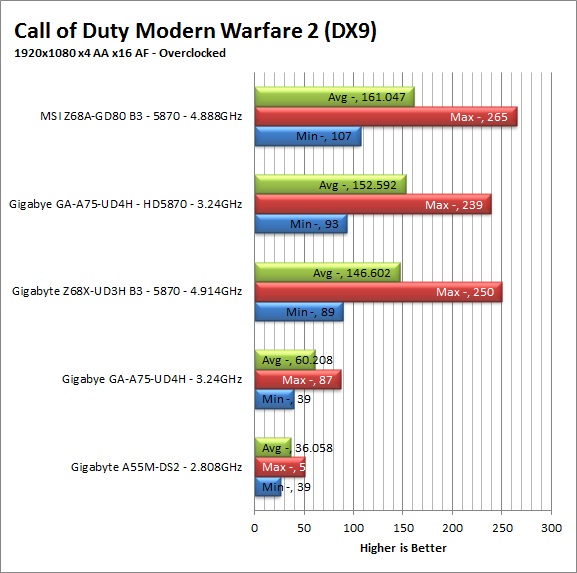
FarCry2 DX10 -
Although not one of my favorite games this tedious game does have some good graphics. The large sandbox style of the game lends to mission based play. The only problem is that the AI is rather low grade. Still the more CPU power the more the bad guys try to do. Over all the game was a little bit of a disappointment to play, but still not a bad DX10 representation. Our testing run starts right after you get your first mission to clean out the safe-house and ends after the hostage rescue. Settings and performance numbers are shown below.
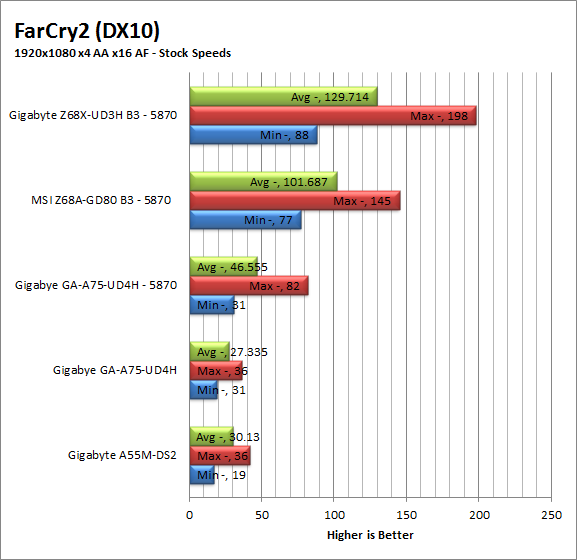
FarCry 2 was playable, but just barely. With a minimum frame rate of 17-18 it could become a terrible slide show style game very quickly. Also many of the effects would cause the game to stutter as the APU/GPU fought to keep up. Long story short; you can play this game (even using DX10), but it will probably not be enjoyable. 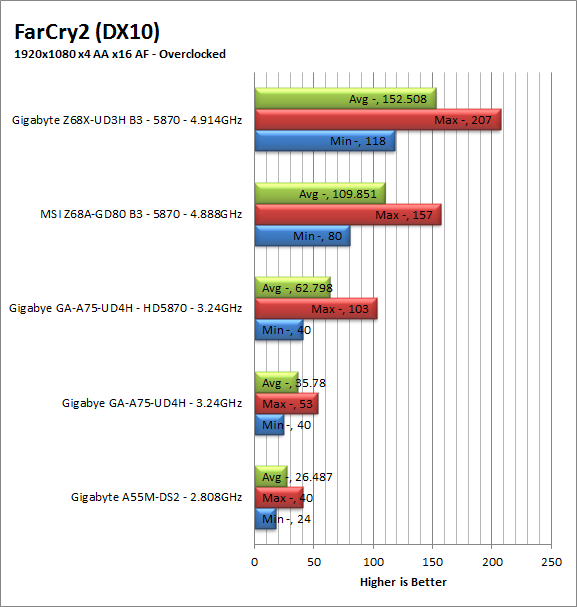
Battlefield Bad Company2 DX11 –
I have liked many of the Battlefield games. They usually tend to be fast paced and fun. With Battlefield Bad Company 2 you do get some of that, but there is something about the graphics and the movement that just does not sit right. The AI is a less sophisticated form of the bar fight AI, but it gets the job done. Still, the game is good for testing as it can put a strain on the components of the board. Out testing run is the entire first level, from beginning to end. Settings are shown below along with the raw numbers.

Wow, unlike the A75 the A55 really took a beating when running Bad Company 2. The game was slow and sluggish. During the bombing runs in the first level the screen jumped around so bad that it was almost impossible to aim. Also your point of view was sluggish to change which made maneuvering around difficult. 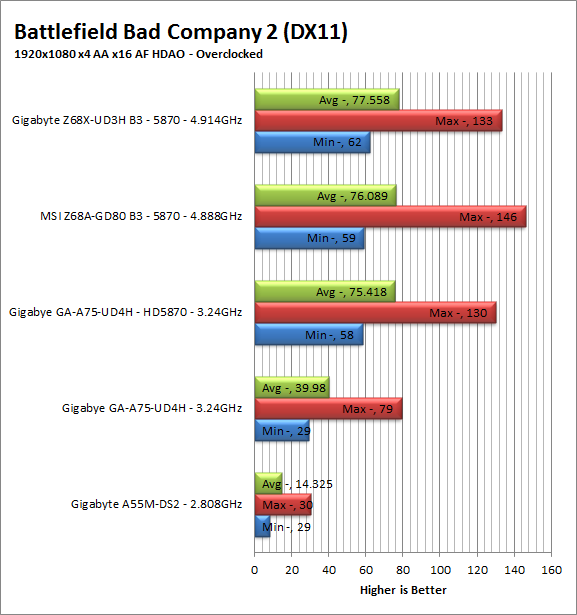
Gaming wrap-up -
The A55M-DS2 is not really meant as a gaming board. Ok so you can probably play older games (HalfLife and possibly HalfLife 2) but you are not going to pull off any new games without losing so much that is makes it not worth the effort.
Value -
Value is another very subjective topic. What is expensive to some might be a deal to others. You can look at this topic in multiple ways. One is raw price and the other is what you get for the money. Each is accurate and both are correct ways to look at price/value. We tend to look at features, performance and real-property when we discuss value. However, we also take into account the raw cash cost of the item.
The Gigabyte A55M-DS2 will set you back $60 from most online stores. This is a good price for an entry level board like the A55M-DS2 especially when you look at the options you have for expansion. True you are not going to be able to drop a 68xx or 58xx series card in here, but you can add a much better GPU and audio card for not that much extra and turn this into a pretty nice HTPC or mainstream gaming rig.
Conclusion -
The Gigabyte A55M-DS2 is not going to win any performance crowns. Then again it is not intended to; the A55M-DS2 is meant as a low cost entry level board with room to grow. When we first looked at it we could not decide exactly where it fit into the market. It seemed that Gigabyte had given the A55M-DS2 an identity crisis. Now looking at the whole picture we find that it is intended as a general usage board at the bottom pricing rung. This means that you can grab this board along with a lower cost AMD APU (like the A-3650) and still have money left over to pick up a better GPU or Audio card depending on your needs. The A55M-DS2 will give you solid performance while allowing you the flexibility to create the system you need it to be, all without breaking the bank.
Discuss in our Forum

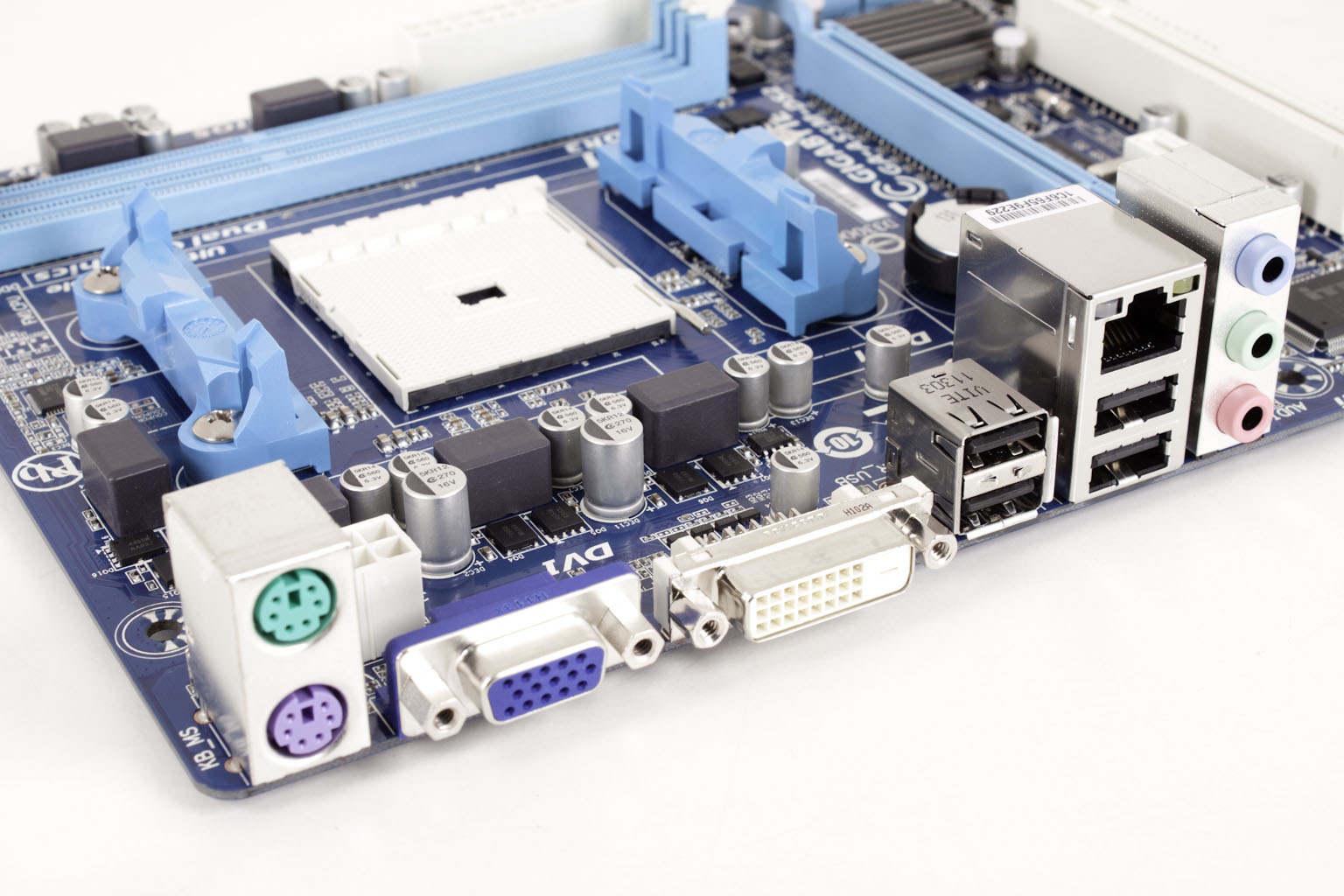 Although AMD’s future is far from certain we do know that they have been pushing towards lower power and lower cost devices. We have seen these in the form of their new APUs and their A75 and A55 chipsets. We have already tested the performance of the A75, now we are ready to take a look at the performance of one of the A55 based motherboards; the Gigabyte A55M-DS2. We have taken a look at the design choices and features so far and have come away with a bit of confusion as to where this product actually fits into the market. Now that we have put the board through our performance tests, let’s see if we can find out exactly where in the market the A66M-DS2 belong and if it is worth your time and money.
Although AMD’s future is far from certain we do know that they have been pushing towards lower power and lower cost devices. We have seen these in the form of their new APUs and their A75 and A55 chipsets. We have already tested the performance of the A75, now we are ready to take a look at the performance of one of the A55 based motherboards; the Gigabyte A55M-DS2. We have taken a look at the design choices and features so far and have come away with a bit of confusion as to where this product actually fits into the market. Now that we have put the board through our performance tests, let’s see if we can find out exactly where in the market the A66M-DS2 belong and if it is worth your time and money.

